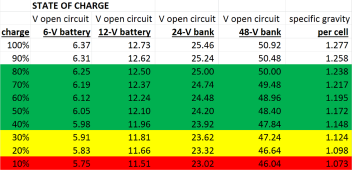OK, let's take another look at the numbers. I could not find any reference for your inverter, but did of another 12V 2000W inverter, which was 2amps. Assuming the inverter is left on 24/7 it's self-consumption is 2A X 12V X 24hr = 576W
LED lights...25W X 10h = 250Wh
Laptop..........65W X 5h = 325Wh
Fan...................60W X 4h = 240Wh
El piano.........20W X 1h = 20Wh
Inverter..........24W X 24h =576Wh
Total = 1411Wh of power. So, if your inverter has the same rate of consumption, your actual consumption is double what your prediction is.
Now, to answer the numbered questions,
1) Not four extra batteries, 4 batteries total. Did you see the math I did for you above, 105Ah battery X 4 batteries =420Ah
2) Here is a battery "state of charge" table. You are grossly depleting your battery down to almost zero. I would make the cutoff 50%, or 12.1V
View attachment 73538
I would completely forget about the frig right now. It uses 70W? Is that 70W on and off all day long? Assuming a 50% duty cycle that's 70W X 0.5 X 24 hours = 840Wh. No way your system, as is, will handle that. Assuming your consumption right now today is ~1400Wh, adding the refrigerator will bump that number up to ~2250Wh. Realisticly by then you'd need at least 3 or maybe four of your 330W panels. Also, sticking with 12V once you reach these power levels, you are really better off with a 24V system.
Since it appears that the inverter itself is the single biggest load, you might be able to save a bit of power in the short term by shutting off the inverter when not in use. What you need to focus your attention on first is getting your battery charged back to 100%. Assuming it's already been repeatedly drained to <10%, your battery has likely already suffered some permanent damage, and might not be able to be brought to 100%. You'll just have to wait and see.



